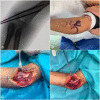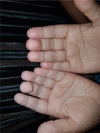Current concepts in diagnosis and management of common upper limb nerve injuries in children
- PMID: 34040654
- PMCID: PMC8138792
- DOI: 10.1302/1863-2548.15.200203
Current concepts in diagnosis and management of common upper limb nerve injuries in children
Abstract
Peripheral nerve injuries (PNI) of the upper limb are a common event in the paediatric population, following both fractures and soft tissues injuries. Open injuries should in theory be easier to identify and the repair of injured structures performed as soon as possible in order to obtain a satisfying outcome. Conversely, due to the reduced compliance of younger children during clinical assessment, the diagnosis of a closed nerve injury may sometimes be delayed. As the compliance of patients is influenced by pain, anxiety and stress, the execution of the clinical manoeuvres intended to identify a loss of motor function or sensibility, can be impaired. Although the majority of PNI are neuroapraxias resulting in spontaneous recovery, there are open questions regarding certain aspects of closed PNI, e.g. when to ask for electrophysiological exams, when and how long to wait for a spontaneous recovery and when a surgical approach becomes mandatory. The aim of the article is therefore to analyse the main aspects of the different closed PNI of the upper limb in order to provide recommendations for timely and correct management, and to determine differences in the PNI treatment between children and adults.
Keywords: median nerve; nerve injury; radial nerve; trauma; ulnar nerve.
Copyright © 2020, The author(s).
Figures





Similar articles
-
Chronic pain and sensorimotor deficits following peripheral nerve injury.Pain. 2010 Dec;151(3):582-591. doi: 10.1016/j.pain.2010.06.032. Epub 2010 Jul 23. Pain. 2010. PMID: 20655145
-
Upper limb nerve injuries in developmental age.Microsurgery. 2009;29(7):529-35. doi: 10.1002/micr.20660. Microsurgery. 2009. PMID: 19412931
-
Lower limb paediatric trauma with bone and soft tissue loss: Ortho-plastic management and outcome in a major trauma centre.Injury. 2020 Jul;51(7):1576-1583. doi: 10.1016/j.injury.2020.03.059. Epub 2020 May 7. Injury. 2020. PMID: 32444168
-
Peripheral nerve injuries in the athlete.Sports Med. 1997 Dec;24(6):385-408. doi: 10.2165/00007256-199724060-00004. Sports Med. 1997. PMID: 9421863 Review.
-
Perioperative Peripheral Nerve Injury After General Anesthesia: A Qualitative Systematic Review.Anesth Analg. 2018 Jul;127(1):134-143. doi: 10.1213/ANE.0000000000003420. Anesth Analg. 2018. PMID: 29787414
Cited by
-
Secondary Ulnar Nerve Reconstruction of High Ulnar Nerve Injuries: A Comparative Study of Sural Grafting and Anterior Interosseous Nerve Transfer.Arch Bone Jt Surg. 2025;13(6):349-358. doi: 10.22038/ABJS.2024.83645.3806. Arch Bone Jt Surg. 2025. PMID: 40641891 Free PMC article.
-
Early post-surgical rehabilitation and functional outcomes of a traumatic ulnar nerve injury: a pediatric case report.Front Neurol. 2024 Feb 7;15:1351407. doi: 10.3389/fneur.2024.1351407. eCollection 2024. Front Neurol. 2024. PMID: 38385043 Free PMC article.
-
Fractured Lateral Humeral Condyle Accompanied by Acute Radial Nerve Palsy in a Child: First Reported Case in the United Arab Emirates.Cureus. 2023 Apr 18;15(4):e37772. doi: 10.7759/cureus.37772. eCollection 2023 Apr. Cureus. 2023. PMID: 37214002 Free PMC article.
References
-
- Senes FM, Campus R, Becchetti F, Catena N. Upper limb nerve injuries in developmental age. Microsurgery 2009;29:529-535. - PubMed
-
- Ristic S, Strauch RJ, Rosenwasser MP. The assessment and treatment of nerve dysfunction after trauma around the elbow. Clin Orthop Relat Res 2000;370:138-153. - PubMed
-
- Culp RW, Osterman AL, Davidson RS, Skirven T, Bora FW Jr. Neural injuries associated with supracondylar fractures of the humerus in children. J Bone Joint Surg [Am] 1990;72-A:1211-1215. - PubMed
-
- Campbell CC, Waters PM, Emans JB, Kasser JR, Millis MB. Neurovascular injury and displacement in type III supracondylar humerus fractures. J Pediatr Orthop 1995;15:47-52. - PubMed
LinkOut - more resources
Full Text Sources
Other Literature Sources
Research Materials

